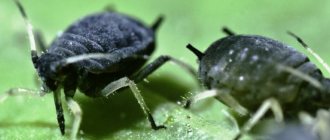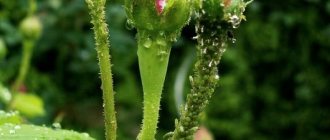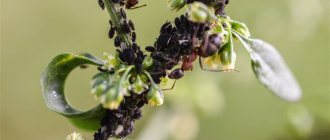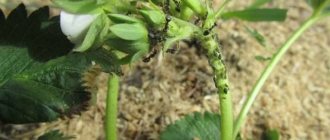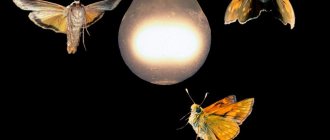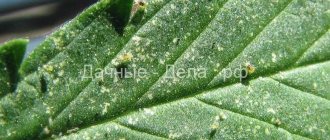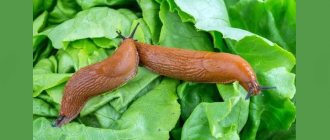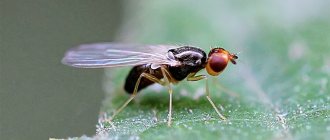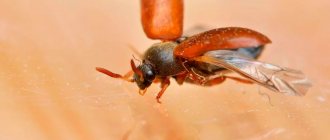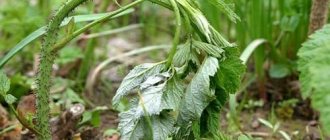Features of a plant parasite
Any plant with soft tissue can be attacked by this small and very harmful plant parasite, but the insect prefers to use the tips of shoots and buds for feeding.
The size of the pest does not exceed a few millimeters. These phytophages, common in our country, have a special proboscis with which they pierce the surface of shoots or foliage. Regardless of the species, aphids have both wingless and winged forms.
Aphids use plant juices for nutrition, which are rich in carbohydrates due to the presence of amino acids. In the process of feeding, aphids secrete a significant amount of a sweet composition called honeydew. This sticky and sweet solution is very attractive to many types of insects and vertebrate pests.
Preventive measures
To prevent pests:
- place trapping belts against ants, since they are companions of aphids;
- destroy the ant clutch by pouring boiling water over it;
Damaged bird cherry leaves.
- Sprinkle the trunk to remove honeydew and sooty fungus;
- clean the peeling bark from the crown and branches;
- feed the plant with nitrogen fertilizers in the spring; in the fall, use fertilizers with potassium and phosphorus;
- do not water the tree often;
- inspect the trunk in a timely manner, trim the crown 2 times a year, remove the affected branches;
- Garden varnish is applied to the cut areas.
Signs of a pest
The common bird cherry aphid or Rhopalosiphumpadi L. is a migratory species of plant parasite and is capable of transmitting viral diseases of cereal crops. The spring generation of bird cherry aphids is characterized by development on bird cherry trees during the period when the plant's buds begin to open . The aphid colony is located on the apical part of the shoots, as well as on the underside of the foliage and flower clusters. In the first half of May, bird cherry is attacked by winged females, and the breeding period is accompanied by the massive formation of dense and dense colonies on various above-ground parts of the plant.
During the summer period, about seven to eight generations of a plant parasite can develop, which use plant sap for nutrition and weaken the growth and development of the plant. In the first half of September, the process of reverse migration of aphids from cereal crops to bird cherry occurs, after which the larvae of the autumn generation hatch. Also, oviposition occurs in the winter , and the oviposition site is the base of a bud on one- and two-year-old shoots, or cracks in the bark.
If aphids have appeared en masse on the bird cherry tree, then it is necessary to treat the plant. To get rid of aphids, you can use chemical insecticides or use effective folk remedies.
Methods for controlling aphids
Aphids on bird cherry
The choice of method to combat small pests depends on the degree of damage to the bushes and the season. If the number of aphids is not large, then in the initial stage of infestation it is better to fight with traditional methods, which will allow you to get rid of aphids on bird cherry relatively harmlessly to humans and plants.
The best chemicals
When there is a massive infestation of bird cherry by aphids, the plant parasite must be combated with highly effective and relatively toxic chemicals. It will not be possible to get rid of the pest using plant remedies, and lost time can be disastrous for the garden crop.
| Drug name | Preparation of working solution | Method and terms of processing | Average consumption rates |
| "Spark" | One tablet per 10 liters of water. First, the tablet must be dissolved in a small amount of water, after which the working solution is brought to a volume of 10 liters. | Several times during the growing season | 10l for 1-5 trees |
| "Inta-Vir" | One tablet must be dissolved in a small amount of water, after which the working solution is brought to a volume of 10 liters. | Spraying the crown of the plant at the end of flowering | Solution in an amount of 2-10 liters per tree |
| "Aktara" | Dissolve approximately 2-4 g of the drug in 10 liters of water. | Several times during the growing season | 10l for 1-5 trees |
| "Fitoverm" | Dilute 2 ml of concentrated emulsion in a liter of water | Spraying during the growing season with 0.2% working solution | Depending on the age of the plant. |
Spraying should be carried out in dry, partly sunny weather, in the evening. The working solution is poured into a special sprayer. If the rules of use are followed, insecto-fungicides are not phytotoxic. The use of tank mixtures is allowed.
Where and where can they appear, what do they look like in the photo?
Aphids can appear on any plant, but there are some favorite ones, for example:
- black currant;
- roses;
- plum and other fruit trees;
- indoor flowers.
Reference. The preferences of aphids differ depending on their type, but absolutely any tree, shrub or flower can be affected by this insect.
Aphid larvae can be introduced with garden soil; their spread is facilitated by wind and ants, which carry the insects on themselves from plant to plant. Aphids overwinter well in various hard-to-reach places on tree bark and plant roots. The main reproduction of the insect occurs through wingless females, which reproduce without fertilization.
At the end of May-June, flying individuals appear, which help spread their offspring over a greater distance and infect a large number of plants. The wind helps to increase the infested area, and the aphids fly away over tens of kilometers. Then mating occurs, after which the female lays eggs in secluded places and the cycle repeats.
Look at the photo to see what plants affected by aphids look like.
Effective folk remedies
If the scale of the damage is insignificant and if the pest is detected at the initial stage of colonization, experienced gardeners recommend using folk remedies that are not toxic, but cope well with the problem of destroying plant parasites.
| Means | Cooking rules | Features of use |
| Wood ash infusion | For 10 liters of water, add 1 cup of wood ash, a tablespoon of mustard and a tablespoon of liquid soap. Pour 3 liters of hot water, stir well and leave for a day | Add the working solution with water to 10 liters, strain and treat the plant twice, at intervals of a week. |
| Tobacco infusion | For 10 liters of water, add 1 cup of tobacco dust or shag, a tablespoon of mustard and a tablespoon of liquid soap. Pour 3 liters of hot water, stir well and leave for a day | Add the working solution with water to 10 liters, strain and treat the plant twice, at intervals of a week. |
| Nettle decoction | Finely chop the young stems, fill the container to ½ volume and add water. Leave for two weeks and strain | Before spraying, the working solution must be diluted with water in a ratio of 1:20 |
| Tansy decoction | Pour 1 kg of fresh plants into 10 liters of water and boil for 2 hours | Before spraying, strain and add 40 g of crushed laundry soap |
| Decoction of tomato or potato tops | Add 4-4.5 kg of chopped tops to a bucket of water and leave for three hours. Boil over low heat for ½ hour, cool and strain | Immediately before use, dilute the decoction with water in a ratio of 1:4 |
| Onion peel infusion | Pour three glasses of husk into 1 liter of hot water and leave for two days. | Before processing, strain the infusion and dilute with water in a ratio of 1:2 |
Wood rot
Wood rot begins to develop due to the tinder fungus. The plant becomes infected through wounds on the bird cherry bark. As wood rots, there is a change in its physical and chemical properties, as well as structure. If you promptly detect the point of penetration of the fungus and strip it down to healthy wood, and also cover it with clay mixed with fungicide, this can save the plant. If the disease is advanced, then the bird cherry can no longer be saved.
How to get rid of growth
Before you start planting young trees and shrubs in an overgrown (abandoned) area, you must get rid of the old growth. Trees should be removed so that the growth does not appear on the site again in the future. It is always difficult to deal with the growth of plum, cherry, sea buckthorn, serviceberry, chokeberry, bird cherry, and American maple. Wild (and the American maple is always a kind of alien), they produce an abundance of root shoots. It is extremely difficult to destroy it by simple physical removal by cutting it onto a stump with pruners or a saw. The shoots will reappear on the site from year to year, trying to grow where you would not expect it at all.
Plants that form root shoots are always problematic. They should not be planted next to crops suffering from root damage (apple tree, plum tree, honeysuckle). Typically, such crops are isolated when planting by digging obstacles made of slate and other durable materials deep into the soil (at least 60–70 cm).
The most aggressive are bush and hybrid cherries (especially poorly fruiting varieties and forms), and some old raspberry varieties. Common cherries (European varieties) and self-rooted plums produce less shoots. In general, the more productive the variety, the less growth there will be.
The average amount of shoots is formed by sea buckthorn. This growth should be removed carefully (covering up the damage) so as not to cause the death of the bush.
Viburnum, golden currant, and shepherdia produce few shoots.
Remedies for growth
There are now an abundance of chemicals on the market, using which the growth can be defeated quite quickly. These drugs are called arboricides; with their help, you can not only remove shoots, but even destroy entire trees. However, such strong chemistry can harm nature and surrounding plants, so it should only be used as a last resort.
Herbicides for shoots
A little safer is the use of herbicides - weed control drugs. How to use herbicides to remove overgrowth? You can simply water the shoots and trees with herbicides, but there will be no benefit from this - the leaves and grass around will dry out, and next year the shoots will begin to grow again. Therefore, herbicides must be used to control trees and shoots in several stages.
Cutting down trees in autumn
I advise in the fall, when there is a downward flow of substances in plants, to cut down the tree at a height of about 25-30 cm, making the cut even.
Make holes in the cut
Using a drill, make vertical holes 5-10 cm deep in the cut. The holes need to be made larger, so choose the maximum diameter of the drill. The number of holes usually depends on the diameter of the cut: with a diameter of 12-16 cm holes, at least 6-8 pieces with a diameter of 1.5-2.5 cm are needed: with a diameter of 30-35 cm - 15-17 holes, etc. Drill holes closer to the edges of the cut, and not in its center - this way you will get into the conductive layers, and not into the wood.
Pour herbicide into the holes
We will pour herbicide into the resulting holes. Glyphosate-based products, such as Roundup, are suitable. You need to dilute it in a ratio of 1:3 or 1:5, then pour the resulting solution into the holes.
Cover the cut
After the herbicide has been poured into the holes, the cut should be covered with plastic wrap or a regular bag. Covering the cut is necessary so that the drug does not lose its strength under the rays of the sun, to prevent its evaporation and to protect it from external moisture, which can wash the drug or reduce its concentration. The shelter will also protect neighboring plants from the effects of the drug, because heavy rain can wash the drug out of the hole, flowing down the trunk, the herbicide will enter the zone of vital activity of other plants.
Repeat the procedure
After about 5-6 days, it is advisable to update the holes: drill deeper or drill a little wider using a thicker drill, fill them again with the drug in the same concentration and cover with film. If necessary, you can repeat this operation again, but usually two are enough.
Uproot trees in spring
After repeating the procedure, you need to leave the plants alone until spring, and in the spring you need to start uprooting already dried and completely dead plants. When uprooting, be very careful to remove all parts of the plant's root system from the soil. Even a small part of the roots remaining in the soil can lead to the restoration of growth activity, and shoots will reappear on the site.
Safety precautions when working with herbicides
When working with herbicide, do not forget about safety precautions: always wear goggles, a respirator and protective gloves. After use, they must be burned; their reuse can lead to poisoning. If the herbicide is accidentally ingested, call a doctor immediately and vomit; if it gets on the skin or eyes, rinse with plenty of water.
Antonov Garden. Newsletter
A selection of the most popular news, useful announcements, free events and competitions. Join a community of passionate gardeners.
SUMMER CALENDAR
GARDEN
FLOWERS AND PLANTS
COUNTRY DESIGN
HOUSEKEEPING AFFAIRS
HEALTHY RECIPES
Antonov Garden - a site for enthusiastic summer residents
We invite you to our cozy corner! We are happy to communicate and are waiting for the light of amateur flower growers, knowledgeable gardeners and experimenters who will give advice and answer questions. We eagerly collect articles, video instructions, photos and master classes throughout Russia so that interesting and necessary materials are conveniently available read and watch.
Now there are already 2000 articles on the cultivation of tomatoes, cucumbers and peppers, caring for apple, pear and plum trees, sowing seeds for seedlings, in a greenhouse and in open ground, shaping trees and shrubs, pinching and pinching vegetables, fertilizing flowers.
It is especially important for summer residents to determine the exact planting dates and favorable days for sowing, watering, fertilizing and pruning. To do this, we regularly publish the current Lunar calendar and post a list of seasonal work from January to December.
Sections are filled with notes on agricultural technology of fruits, berries, flowers and vegetables. There are clever gardening techniques for all climate regions. When to plant onions and garlic in the Moscow region? How to care for grapes in the Middle Zone? Which varieties to choose for the Far East? How to cover roses in Siberia?
Every day we add texts on how to maintain the health of seedlings, protect young shoots from harm and provide residents of a suburban area with a nutritious diet and proper nutrition. Visitors are happy to share observations of how the inhabitants of greenhouses and beds are gaining strength. Together we are looking for effective ways to effectively combat diseases and pests, and we are calculating the norms of fertilizing and fertilizers.
Do you want to show off the largest tomatoes? Looking for the best samples for pickling? Are you looking to serve an early harvest? Trying reliable ways to get rid of weeds? Feel free to ask in the “Question-Answer” section and receive quick and accurate answers. Experienced experts, agronomists, researchers and experienced hobbyists will proudly share personal life hacks and tips.
Gardeners are passionate about creating amazing oases filled with the beauty of plants and bountiful harvests! Tell us how you accommodated exotic guests in your garden beds, and what foreign novelties you dared to try. Show photographs and describe observations of the garden. The editors and readers will be happy to find out what is grown in Transbaikalia and Primorye, Leningrad and Moscow regions. Do you sell and buy seedlings? Looking for rare collectible seeds? Place private advertisements about buying and selling, searching and providing services. What if there are giant tomatoes of the author's selection right in your region or sent from the Urals!
Well, when you want to take a break from what you love, look into Healthy recipes - for a healthy body and a tasty table. Simple masks and creams at home, delicious preparations, salads, compotes and kebabs - everything that pleases the season and resembles the taste of fresh fruits on winter evenings. Antonov Garden welcomes everyone for whom dacha and farming are a source of joy and a piece of their soul!
Source
Biological products
You can protect bird cherry from aphid attacks using products based on waste products of fungi, bacteria, and other microorganisms. The action of biological products is not as rapid as that of insecticides, but does not cause harm to the environment.
It is necessary to spray the plant in dry, windless weather. Rain significantly reduces the effectiveness of the drug. The procedure should be repeated after 14 days. For prevention, use the drug once a month.
The most popular remedies for aphids on bird cherry:
The drugs disrupt the natural processes in the body of insects and lead to death.
It is necessary to begin pest control in late autumn, removing weeds from the garden, digging up the soil, pouring warm water over the bird cherry, the effect is consolidated in early spring. Preventive measures are carried out throughout the warm season.
Source
